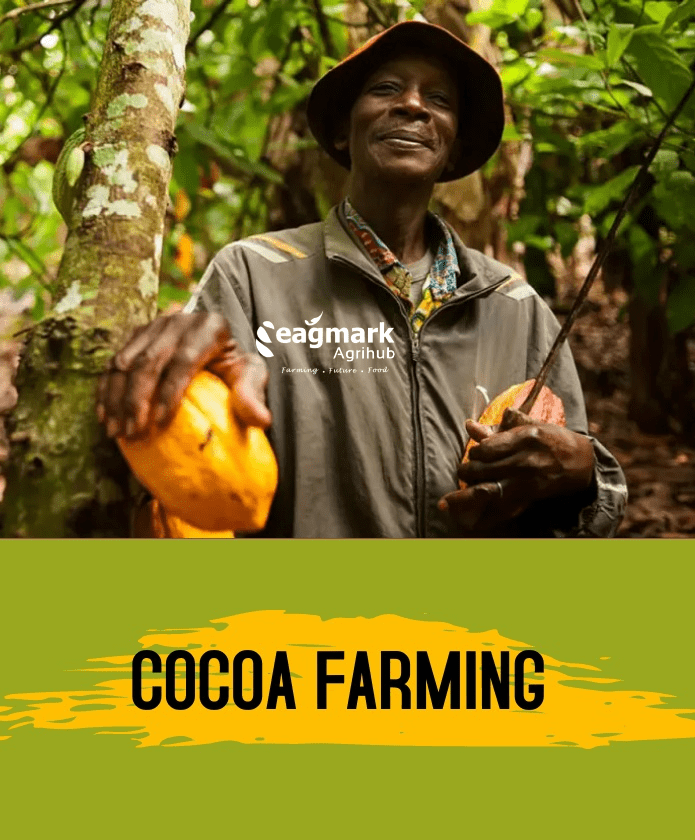The Struggle for Sustainable Cocoa: The Complex and Often Overlooked World of Cocoa Farming

Cocoa farming is a vital and often overlooked industry that provides the world with one of its most beloved treats: chocolate. Cocoa is primarily grown in countries located within 20 degrees of the equator with the majority of production occurring in West Africa, South America, and Southeast Asia.
Cocoa farming is an important industry in many countries around the world, and it plays a vital role in supporting the economies of cocoa-producing countries. However, it is also facing a range of challenges, including low and volatile cocoa prices, limited access to resources and technology, the impact of deforestation, limited availability of land for cocoa cultivation, and the impact of climate change and pests and diseases.
In the African continent, Cocoa is grown majorly in West Africa, which is the largest cocoa-producing region in the world, accounting for around 70% of global production. The top cocoa-producing countries in West Africa are Côte d’Ivoire, Ghana, and Nigeria. Cocoa farming in West Africa is often characterized by small, family-owned farms and low productivity levels.
South America is the second-largest cocoa-producing region, with countries such as Brazil, Ecuador, and Peru being major producers. Cocoa farming in South America is often more mechanized than in West Africa, with larger farms and higher productivity levels.
In Asia, the crop is mainly grown in the Southeast region, with Indonesia and the Philippines being the main producers. Cocoa farming in Southeast Asia is often characterized by smallholder farmers and low productivity levels. It is also facing a range of challenges, including the impact of deforestation and the limited availability of land for cocoa cultivation.
The Cocoa Crop
Growing cocoa is a labor-intensive process that requires a great deal of care and attention. Cocoa trees can take up to five years to mature and begin producing cocoa pods, which must be harvested by hand. Additionally, cocoa trees are sensitive to their environment and require specific conditions to thrive. 
They need to be grown in areas with high humidity, plenty of sunlight, and well-draining soil. They also require regular pruning and fertilization to maintain their health and productivity.
Cocoa pods come in a variety of shapes and sizes, and the quality of the cocoa beans inside can vary greatly. The best cocoa beans are those that are plump and have a deep, rich color. After harvesting, the pods are then cracked open to reveal the cocoa beans, which are fermented and dried before they can be shipped and processed into chocolate. The fermentation process is a crucial step in producing high-quality cocoa beans. It involves placing the cocoa beans in boxes or baskets and allowing them to ferment for several days. This helps to develop the flavor and aroma of the cocoa beans.
Exploring the Complexities and Challenges Faced by Farmers
One of the major challenges facing cocoa farmers is the issue of low and volatile cocoa prices. Cocoa prices are subject to fluctuations due to a variety of factors, including weather conditions, and pest outbreaks. The cocoa market is also influenced by a variety of factors, including political instability, economic conditions, and global demand. This makes it difficult for farmers to plan for the future and invest in their farms.
Cocoa farmers often have to deal with a variety of pests and diseases, with the most destructive pest being the cocoa pod borer, a moth that can devastate entire cocoa plantations. Farmers however tend to use a variety of methods to control pests, including the use of chemical pesticides, biological controls, and cultural practices such as crop rotation.
Another challenge is the limited access to resources and technology for many cocoa farmers. Many cocoa farmers live in remote, rural areas with limited access to education, healthcare, and other essential services. This can make it difficult for them to improve their farming practices and increase their yields.
Climate change is also a major threat to cocoa farming, with rising temperatures and changing rainfall patterns affecting the quality and productivity of cocoa crops. This is a major concern for cocoa farmers and the industry as a whole, and efforts are underway to develop cocoa varieties that are more resistant to these changes.
The expansion of cocoa farming has often led to deforestation and the destruction of natural habitats, causing significant environmental and social impacts. The destruction of natural habitats has been detrimental to the environment due to the loss of biodiversity, the disruption of ecosystem services, and the contribution to climate change. It has also h negative impacts on the social and economic well-being of local communities, which rely on forests for their livelihoods and cultural practices.
Efforts are underway to address the issue of deforestation in the cocoa industry, including through the promotion of sustainable cocoa farming practices and the development of certification programs that require cocoa producers to adhere to certain environmental and social standards. However, much work remains to be done to ensure that cocoa is produced in a way that is environmentally and socially responsible.
Human Rights Issues
Child labor and exploitation in the cocoa industry is a serious and complex issue that has garnered significant attention in recent years. Many children in cocoa-producing countries, particularly in West Africa, are forced to work long hours on cocoa farms under hazardous conditions, often for little or no pay. 
Efforts are underway to combat this issue and promote child-labor-free cocoa, including through the implementation of programs that aim to educate farmers and provide them with alternative sources of income. However, addressing this issue is complex and requires the efforts of a range of stakeholders, including governments, cocoa companies, and civil society organizations. It is important for all those involved in the cocoa industry to work together to ensure that children are protected and that cocoa is produced in a sustainable and ethical manner.
In recent years, there has been a growing demand for sustainably grown cocoa, with consumers and chocolate companies looking for cocoa that has been produced in an environmentally and socially responsible manner. This has led to the development of various sustainability certification programs, such as the Rainforest Alliance and Fairtrade International, which aim to improve the lives of cocoa farmers and protect the environment.
A Taste of Success: The Dedication and Determination of Cocoa Farmers
Despite the challenges, cocoa farmers around the world continue to work hard to produce high-quality cocoa for the global market. The cocoa industry also plays a vital role in supporting the economies of cocoa-producing countries, providing employment and income for millions of people.
So, the next time you enjoy a delicious chocolate bar or cup of hot cocoa, take a moment to appreciate the hard work and dedication of cocoa farmers around the world. Without their tireless efforts, we wouldn’t have this beloved treat to enjoy.




2 comments
Vickie
January 5, 2023 at 12:57
Great read!
Eagmark
January 5, 2023 at 12:59
We are glad you liked it Vickie. Thank you.